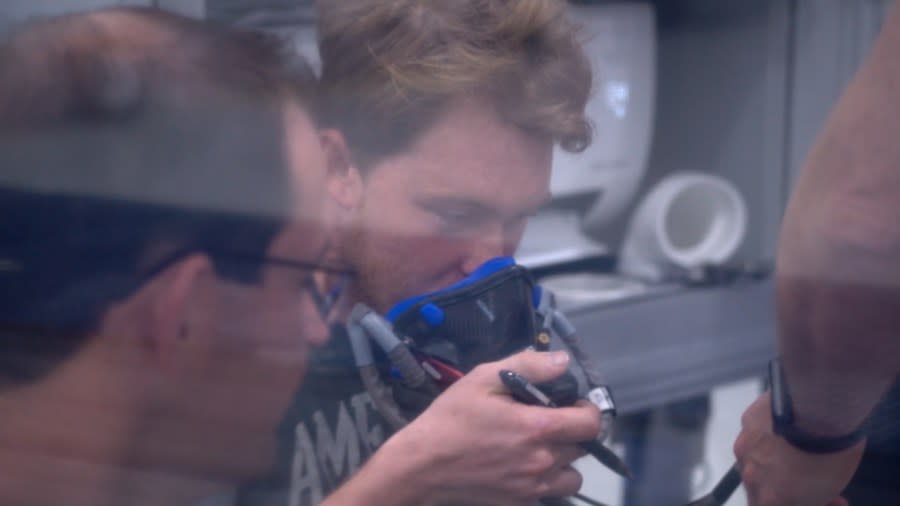Altitude Sickness Danger: Pilots train in Concord for oxygen emergencies

CONCORD, N.C. (QUEEN CITY NEWS) — How long could you last without oxygen at high altitudes?
If you’ve been to places like Aspen, Colorado, at an elevation of 8,000 feet, your body most likely needed time to adjust to the thinner air. The higher you go, the air has less pressure, with less oxygen available in each breath. That may not be a big deal on the ground, but for pilots flying aircraft at higher altitudes, the lack of supplemental oxygen can be deadly.
Avelo Airlines adds cheap nonstop flights to the northeast from Concord airport
“At 25,000 feet, the normal time for useful consciousness ranges between five to seven minutes. Up to 34,000 feet and higher, range from 15 to 30 seconds, that is, if no oxygen mask or supplemental oxygen is available,” warns FAA Instructor and Aviation Physiologist J.R. Brown.
Brown is training pilots for oxygen emergencies by putting them through the wringer — a chamber that simulates an altitude of 25,000 feet — that has pilots starving for air.
“We’re not trying to kill then. We don’t want them to pass out,” Brown explains.
Brown is at Victory Lane Aviation at Concord-Padgett Regional Airport. It’s one of his nationwide stops with the traveling PROTE Chamber, a portable remote oxygen training enclosure capable of producing a reduced oxygen environment at ground level. It’s an altitude simulator that helps pilots recognize the signs of Hypoxia- better known as altitude sickness before it’s too late. It’s a dangerous condition that happens when your body doesn’t get enough oxygen.
“If a pilot has never experienced hypoxia before, the wrong time to discover it is when they are flying the aircraft, so we want them to discover it in a safe simulated environment before they get in the aircraft, so they experience the symptoms and always know what to look for,” says Brown.
Boeing’s first astronaut launch is off until late next week to replace a bad rocket valve
While there are Federal Aviation Regulations that require pilots of unpressurized aircraft to use supplemental oxygen at certain altitudes, often altitude sickness affects aviators at lower heights. Recognizing the signs, before they turn dangerous- is key.
In the PROTE Chamber, the pilot wears a pulse oximeter on their finger, which normally reads 98% blood oxygen saturation. As they breathe in the chamber’s reduced oxygen at 25,000 feet, the pilot’s well-being deteriorates rapidly. Within 3 minutes, their blood oxygen drops to 65%. That’s when they are required to don an oxygen mask before passing out. In those few minutes, they have time to notice the symptoms that are unique to hypoxia.
Lack of oxygen can have a dangerous effect- impairing a pilot’s judgment, focus, and response time. The onset of Hypoxia is insidious. Symptoms may develop so gradually they are already established before you recognize them.


Brown says the most common symptoms include slowed fuzzy thinking, euphoria, tingling, dizziness, headache, nausea, anxiety apprehension, and air hunger or starving for air.
Pilot Stacy Engelmohn, a PROTE participant says, “I got light-headed, tried to do math, for the life of me I couldn’t do simple math, even.”
Eventually, as levels of oxygen fall, they can drop so low, they are not enough to sustain bodily function.
Flight Instructor and PROTE experiencer Dillon Ratkowski notes “It’s one thing to read about Hypoxia in a textbook, and quite another to experience it first-hand. An invaluable real-life lesson.”
Brown says once a pilot observes their symptoms, they will always be the same for that individual, appearing in the same order. This can help them recognize the urgent need to use supplemental oxygen if available or descend the aircraft. These are the only cures- and the only way to prevent the eventual loss of consciousness that could lead to death.
The PROTE Chamber is part of a free pilot safety program made possible by the FAA Safety Team.
“The FAA’s mission is safety through education, keeping the airways safer for everybody,” concludes Brown.
For the latest news, weather, sports, and streaming video, head to Queen City News.

